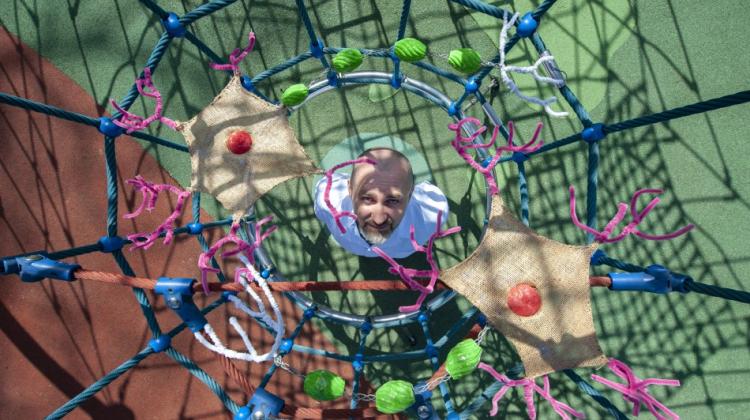Number of people with Alzheimer's disease is growing faster than the number of elderly people
 Credit: Adobe Stock
Credit: Adobe Stock
The number of cases of Alzheimer's disease is growing rapidly, and current treatments have a limited effect. New drugs are urgently needed, but so are better diagnostic methods. As part of the Alzheimer Prediction Project, experts from Poznań are working on one of such methods.
Consequently, psychiatrist Dr. Marcin Górniak is leading a study in which scientists from the Adam Mickiewicz University in Poznań and the Poznań University of Technology are developing an innovative method for the early detection of Alzheimer's disease, intended for general use. For the Alzheimer Prediction Project and for 'a positive approach to disseminating research results among the public', Dr. Górniak has just been nominated for the Scientist of the Future 2023 award.
PAP: Is it true that more and more people are suffering from Alzheimer's disease?
Dr. Marcin Górniak: Yes. The main reason for this is the ageing of the population. Age is the main risk factor for this disease. In the population over 65, the percentage of people with dementia (the main cause of which is Alzheimer's disease) doubles every five years worldwide.
PAP: Several genes are known to be predisposed to the disease, but this disease is also said to be very 'democratic', that practically anyone can get sick...
M.G.: Three so-called causative genes have been identified, the presence of which somehow determines that a given person will get sick. At the same time, these three genes account for a small percentage of all cases. Another gene has also been identified that increases the risk of the disease, but does not determine the disease (APO E4). There are probably many different causes behind the remaining cases, perhaps numerous other, yet undiscovered genes with a small independent impact, the effect of which may be cumulative. Certainly important are the so-called epigenetic factors, those regulating gene activity, as well as environmental factors, preventive measures. However, there are currently no effective methods of preventing the disease - indeed, anyone can get sick.
PAP: The disease has been known about for over a century, and there is no effective cure. Why?
M.G.: It was indeed described in the beginning of the 20th century. Initially, it was considered quite rare, which was associated with a low average life expectancy. As it lengthened, the disease became an increasingly serious medical and social problem. Unfortunately, we currently only have symptomatic treatment, but it should be strongly emphasized that - despite its limited effectiveness (especially in comparison to drugs used in the treatment of other mental disorders) - this treatment can significantly slow down the course of the disease, alleviate its symptoms, including the ones that are the most problematic for the patient and his carers. Despite this for very different reasons - but also due to limitations in diagnostics - this potential is still untapped.
Honestly it must be said that a therapy that would work on the root cause of the disease probably does not exist yet. I say probably because last year, after many years of painstaking research, the first new drug was registered in the US that works completely differently than the previous ones.
PAP: How does it work?
M.G.: It affects the so-called amyloid cascade, which is still postulated to underlie the disease process. Unfortunately, the modest therapeutic effect of the new drug causes some dissatisfaction, even if you do not take its high price into account. The drug slowed the progression of the disease by 27 percent compared to placebo over the course of a year, which is a statistically significant effect, but it is not clear to what extent this will translate into benefits in the real life of patients and caregivers.
On the other hand, given the chronic nature of the disease, the effect could become cumulative in subsequent years. The drug is also of limited use when it comes to the patient population in which it can be used: confirmation of amyloid pathology as the cause of memory impairment is required. In addition, the drug cannot be used in a later phase of Alzheimer's disease than mild dementia. However, this is certainly not the last word of the pharmaceutical industry. Even this month, there was a report of another similarly acting drug. Unfortunately, its effectiveness and use limitations are similar.
PAP: Can research on other mechanisms involved in the development of the disease bring anything new? Some time ago, it was even questioned that the deposits of a defective protein - amyloid beta - accumulating in the brain were the main cause of the disease.
M.G.: That was a high-profile case in which it was pointed out that the results of research, on which the current knowledge about the causes of the disease was based, had been manipulated. Nevertheless, autopsies - which are still the most important research confirming the final diagnosis of Alzheimer's disease - indicate a common role of this protein in the pathogenesis of the disease. So even if there was some manipulation, the hypothesis of the amyloid cascade was not called into question. I would like to also mention that amyloid deposits (obviously not yet defined in terms of chemical composition) were first described by Alois Alzheimer, who was not only an excellent psychiatrist, but also a brilliant pathologist.
PAP: Are there any studies on drugs that would act on other mechanisms, perhaps ones that accompany the basic mechanism?
MG: Yes, of course. It is now accepted that it is almost impossible for a single substance to solve the very complex problem of Alzheimer's disease. Researchers currently focus on the treatment of early, prodromal stage of AD. Most of the tested drugs are supposed to interfere with the mechanism of beta amyloid accumulation. There are also drugs under investigation that are intended to prevent the accumulation of another abnormal protein, tau. It should be emphasized that these processes - the accumulation of amyloid protein and tau protein - are interrelated, and the use of the aforementioned latest drug that prevents accumulation of amyloid also contributes to the inhibition of the accumulation of pathologically altered tau protein. Research is also being conducted into drugs that can be used in the later stages of the disease, although there are fewer such studies.
PAP: Still, one can get the impression that it may be difficult to make a breakthrough in the next five to 10 years...
M.G.: We don't know that. Alzheimer's drug trials do have a very high failure rate, as high as 98 percent. With what we now know about the process underlying the disease - that is, knowing that this process takes place secretly for up to 20 years before symptoms appear that can be detected in a clinical trial, it is easy to pinpoint the cause of these failures, i.e. too late intervention. It should come as no surprise that it is difficult to stop a process that has been going on for so long.
We know that the earlier treatment starts, the better the prognosis. We know this situation well, for example, from cancer treatment, and fortunately, awareness of this is common, not only in the medical community. The secrecy of the process, its length, the irreversibility of changes after crossing a certain threshold and the lack of effective treatment result in the closure of a vicious circle: we cannot discover an effective drug because we do not study enough patients early enough. Patients, on the other hand, do not come forward because there is no effective treatment… It is difficult to consider this attitude completely irrational.
PAP: Doesn't that mean that there is a big task for diagnostics?
M.G.: Certainly. Imagine a situation where a pharmaceutical company markets an effective drug in the treatment of early stage Alzheimer's disease - then the lack of availability of appropriate diagnostic methods useful at this stage of the disease may turn out to be a tragedy.
PAP: What diagnostic tools do we currently have?
M.G.: Positron emission tomography (PET) is used in early diagnosis of the disease. However, the cost of such a scan is approx. PLN 10,000, and even if someone has this kind of money, there are about 30 tomographs of this type in Poland. Therefore, we cannot treat this as a useful option in screening tests.
Another method is the analysis of cerebrospinal fluid, but here we encounter a similar problem - a limited number of neurologists. Similarly, neuropsychological tests are a precise tool, but they require a lot of work and an experienced neuropsychologist.
Although research is underway on tests to confirm the diagnosis of Alzheimer's disease based on markers in the blood of patients, some scientists question their specificity and sensitivity. This type of test was registered in Japan earlier this year. Similar tests are commercially available in the US. The cost of one test is over $1,000. Therefore, there is an urgent need to develop diagnostic tools that meet the criteria of screening tests: easy to use, non-invasive, with sufficient sensitivity and specificity.
PAP: What are the chances that they will be developed in the near future?
M.G.: We are working on it (and we are certainly not the only ones). We managed to build a team of specialists from various fields, mainly scientists from the Adam Mickiewicz University in Poznań and the Poznań University of Technology, and pre-examine some of the people who have already volunteered for our study. This group includes both people complaining about memory deterioration and people without such problems, forming a control group. With the help of a battery of tests, we check how a given person copes with various cognitive tasks. It is a functional test, a type of additional test used in medicine in addition to laboratory tests (e.g. blood tests) or imaging (such as computed tomography, ultrasound, X-ray examination). It is a bit like a stress test of the heart, in which the work of the organ and the ECG graph are observed under increasing load.
If our test allow us to preliminarily identify people who require further specialized diagnostics, more complicated tests - we would consider this a success. It may also turn out (this is of course a very optimistic assumption) that our method will be so sensitive that further tests will no longer be needed. Such tests could also possibly help in the development of better treatments.
PAP: How?
M.G.: For example, thanks to the possibility of easier monitoring of the course of the disease, tracking its dynamics, reaction to drugs and other procedures.
PAP: When do you expect the first results?
M.G.: The first results will be presented in September at the conference 'Open Seminar in Acoustics'. If everything goes according to plan, we will present further, more detailed results early next year. Much depends on the public response, because even the best team of scientists is not able to conduct these studies without the participation of the right number of patients.
PAP: What criteria must they meet?
M.G.: We are looking for people who are still healthy, but at the highest risk of falling ill in the coming years. So, first of all, people over 60 who notice problems with fresh memory, i.e. regarding current events. We are also looking for younger people (but rather over 55) who have family members who developed symptoms of Alzheimer's disease before their 65th birthday. We also invite people over 60 years of age without memory disorders, but who have relatives who became ill later in life (after the age of 65).
Of course, not all of these people will be diagnosed with the early stages of the disease. These people will constitute the control group, and the obtained information about the exclusion of the disease will be a kind of bonus for the time spent on participating in the study. Extensive information about the study and how to participate in it can be found at: www.alz.put.poznan.pl.. The study is conducted in Poznań and requires several separate visits to research facilities.
PAP: At the beginning of the interview, you mentioned factors that increase the risk of the disease, which we can have some influence on. How can you reduce the risk of getting sick?
MG: There are a number of so-called modifiable factors, the consideration of which may reduce the risk to some extent. These include, for example, vascular and metabolic factors, i.e. an appropriate diet that allows you to maintain the proper level of glucose or cholesterol in the blood. It is important to take care of blood pressure, proper body weight, physical and mental activity, as well as appropriate treatment of heart rhythm disorders, depression, anxiety, sleep disorders, including sleep apnoea. It is worth avoiding toxins such as alcohol, cigarettes or polluted air. Caution should be exercised when handling sedatives and drugs used for other conditions that have a negative effect on memory. If there is an alternative to these drugs, it is best to use it.
PAP: How effective can such measures be?
M.G.: Such prevention introduced in several countries including the USA, the Netherlands, France, the UK, South Korea, brought unexpectedly good results. There was a significant decrease in the number of cases compared to previous forecasts (in Korea, for example, by 40 percent!).
At this point, it is worth recalling the exponential nature of the incidence of Alzheimer's disease. Delaying the onset of the disease by 5 years would reduce the total number of patients by half! There is also no more effective, cheaper - and most often more pleasant - way to combat diseases than prevention. However, such constant preventive measures also require motivation on the part of patients, and it is certainly easier to maintain it if people are aware of the risk of the disease. This is also the purpose of the screening method developed by our team.
Interview by Marek Matacz, PAP - Science in Poland
mat/ agt/ kap/
tr. RL
Przed dodaniem komentarza prosimy o zapoznanie z Regulaminem forum serwisu Nauka w Polsce.



















